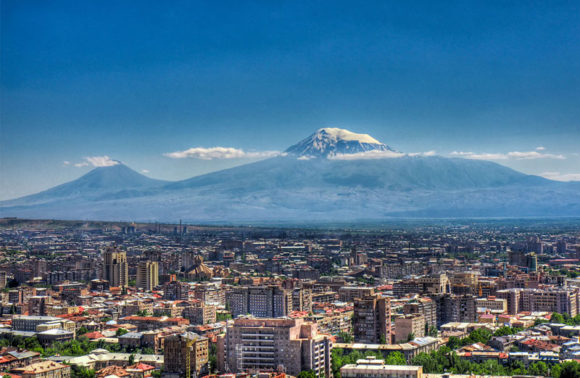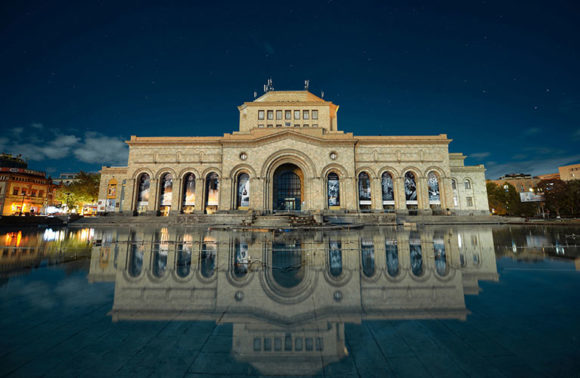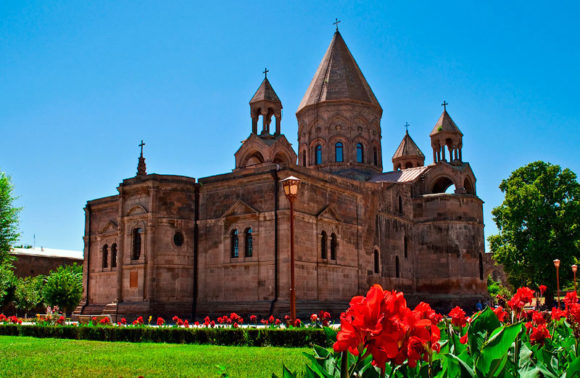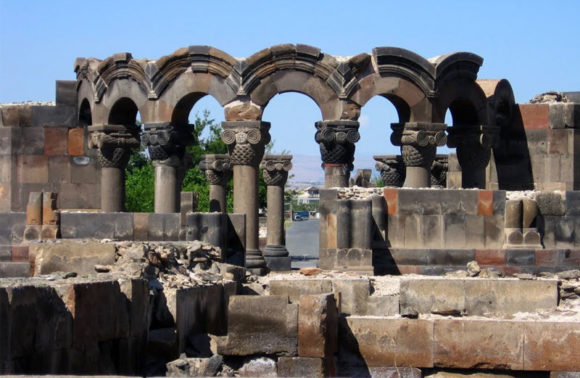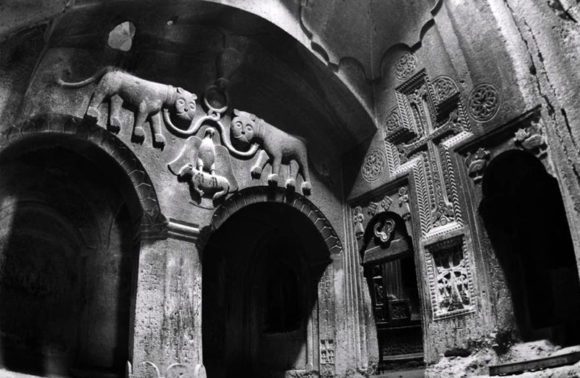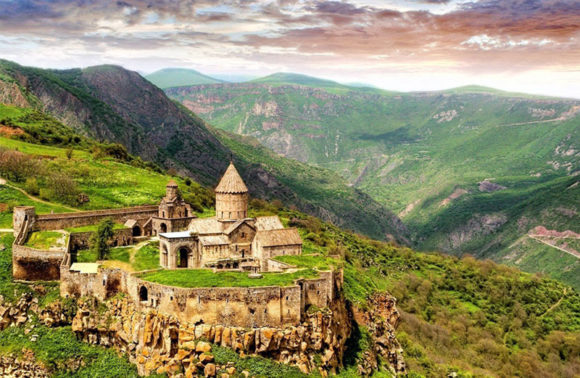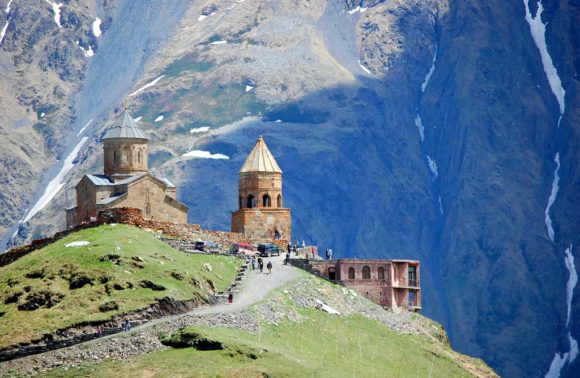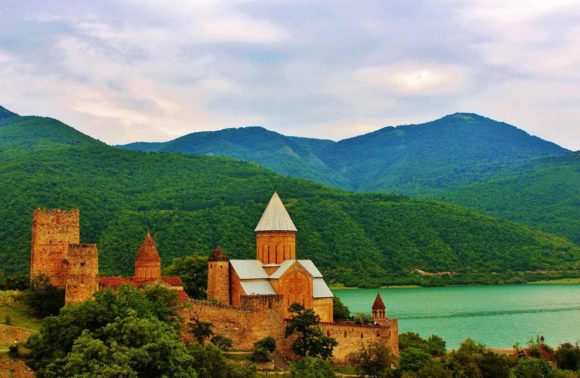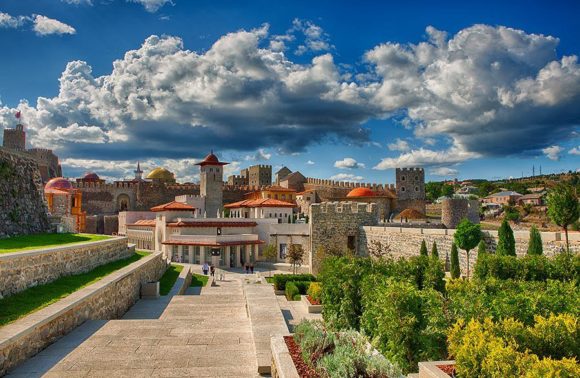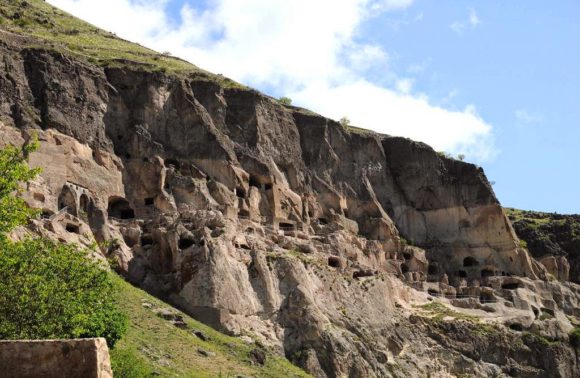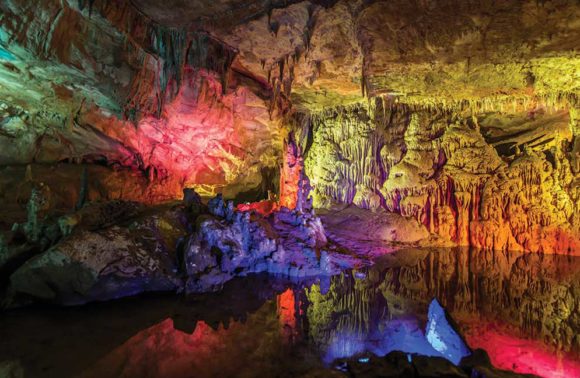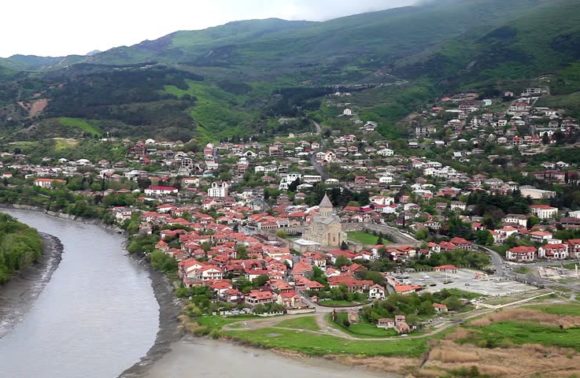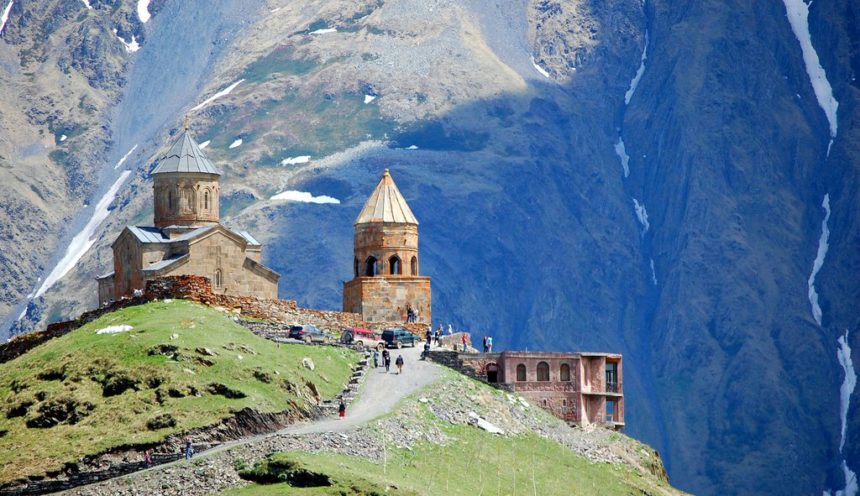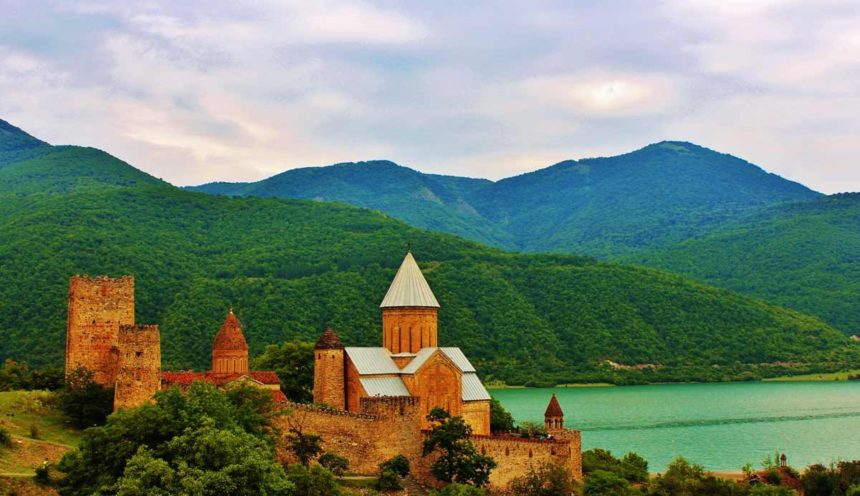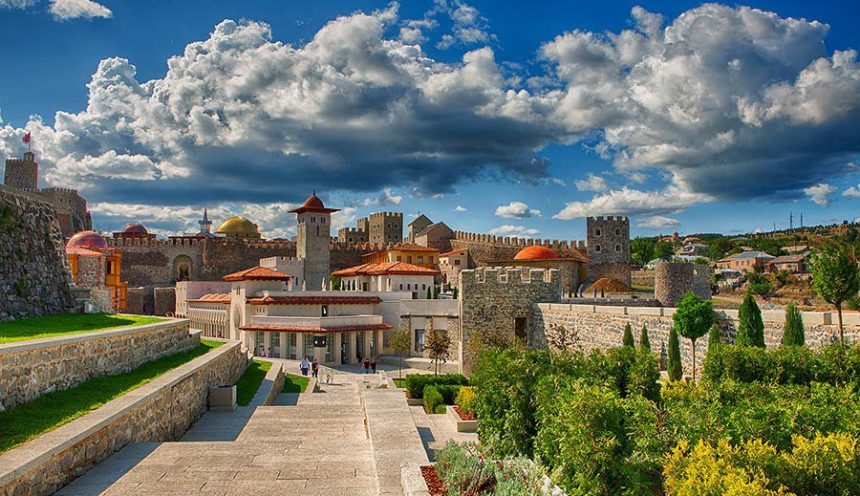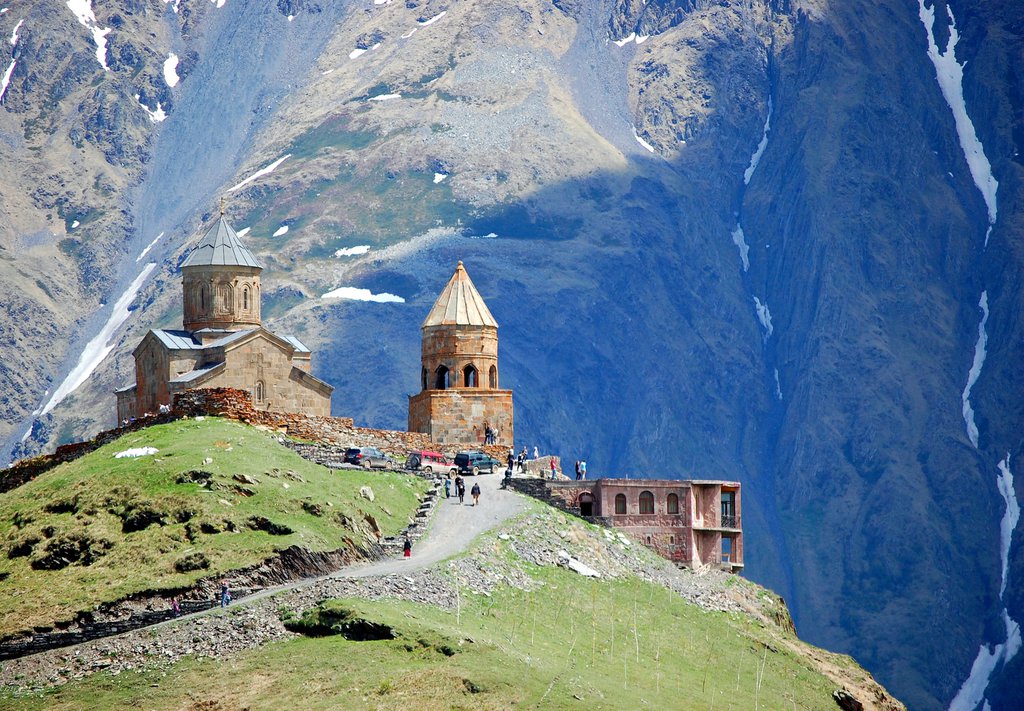
Tour Itinerary
-
Day 1: Arrival to Yerevan
Arrival to Yerevan International Airport Zvartnots. Meet and assist at the airport. Transfer to your hotel in Yerevan. After the check-in process at the hotel, you will have time to rest. Overnight.
-
Day 2: Yerevan City Tour & History Museum, Cognac Factrory.
Breakfast at the hotel. The tour will start with panoramic city tour of Yerevan. Along the way you will see the Sports and Concert complex, Kievyan Bridge, Baghramyan Avenue, the Presidential Palace, Academy of Sciences, National Parliament and the Opera House. You will also visit the History Museum which houses collections of Armenian artifacts from the fields of archaeology, ethnography and the fine arts exhibit. We will continue the sightseeing with a visit in Brandy factory with tasting of 3 types of famous Armenian cognac. Lunch during the tour. Back to the hotel. Dinner at a traditional Armenian restaurant. Overnight in Yerevan.
-
Day 3: Yerevan - Echmiatsin - Zvartnots – Garni - Yerevan
Breakfast at the hotel and the tour start. First stop at Echmiatsin – the oldest and most important Armenian temple. Built between 301-303 AD, it is the oldest Christian cathedral in
the world. Next, we will visit Zvartnots which boast of a precious, though ruined, architectural complex of buildings from the 7th century. The complex includes the Zvartnots temple of St. George and the palace of Katholikos Nerses III, known as a “Builder”. The Zvartnots temple, built as a main Armenian cathedral in the years 641-661 was supposed to outshine the cathedral in Echmiatsin. Lunch in a restaurant with a beautiful view on the Geghard monastery with local specialties of Armenian cuisine. Drive to Geghard, a monastic complex carved in solid rock in 1215. It is famous for being the resting place of St. Andrew and St. John, and for the legend of a hidden relic – the Spear of Destiny – said to be the one that pierced Jesus Christ on the cross. We will continue with a visit to Garni, a temple from the 1st century AD dedicated to the Sun God Mitra, resembling the Parthenon in Athens. The constructor of the temple was Tiridates, a king crowned by the Roman emperor, Nero.
After the visit in Garni we will return to Yerevan for the dinner and overnight stay. -
Day 4: Yerevan - Goris - Tatev - Karahunj - Goris
After breakfast we will depart to Tatev Monastery nearby Goris. Tatev Monastery is located 1600 high in the mountains, in Zangezur. The monastery was built in an incredible harmony with the picturesque landscape creating an impression as if it was an inseparable part of its natural surroundings. It was founded in the 4th century at the site of a pagan temple. According to Stepanos Orbelyan, an Armenian historian, the founders of the church were Prince Ashot, his wife Shushan, Grigor Supan, the ruler of Gegharkunik, and Prince Dzagik. Then we will drive to Karahunj. Zorats Karer or Karahunj, is an ancient archaeological site with megalithic structures called “singing rocks”. It was founded between 7600 BC and 4500 BC which means the site is much older than the Stonehenge in England. The site served both as an ancient temple and an astronomical observatory. It is an impressive sight: over 200 basalt stones, each weighing up to 10 tons – aligned in an arch shape. Dinner and overnight in Goris.
-
Day 5: Goris - Ughtasar - Goris
Drive to Ughtasar after breakfast. Lost in the mountains, a lake with crystal clear waters will reveal memories of prehistoric times. At Ughtasar we will find petroglyphs carved in stones dated between 5,000 and 2,000 years BC. The mysterious petroglyphs depict hunting scenes, farming, zodiac signs and wild animals: goats, deer, wild cats. The petroglyphs offer a unique insight into the lives of our ancestors thousands of years ago. Lunch in Sisan. Dinner and overnight stay in Goris.
-
Day 6: Goris -Caravanserai –Noratus – Dilijan
After breakfast drive to Caravanserai to see the Selim Mountain Pass where the caravans on the ancient Silk Route rested on their way, while transporting precious goods, including exotic spices, from China to Europe. Lunch. After lunch we will take a scenic drive along the Sevan Lake, it is a truly impressive sight – the lake supplies water to 28 rivers and is the source of the Hrazdan river. In the sun the perfectly still water surface turns almost turquise. It is the biggest Armenian lake and one of the highest located lakes in the world. We will arrive to the medieval cemetery in Noratus, the biggest collection of Armenian ‘khachkars’ (memorial steles carved in stone with intricate crosses, floral and religious motives and beautiful rosettes). You can see khachkars also in the Armenian monasteries and at the entrances of medieval tombs. The oldest date back to the 7th century. Dinner and overnight stay in Dilijan. Dilijan is a land of natural, pristine forests and rivers with scenic views – the memories of this beautiful region will stay with us for a long time.
-
Day 7: Dilijan -Haghpat – Sanahin - Akhaltsikhe
In the morning we will drive to Haghpat. The Lori region is a land uncontaminated by civilization – we will visit the medieval monasteries: Haghpat and Sanahin from 10th-13th centuries, precious examples of Armenian architecture. The architectural complexes of Haghpat and Sanahin are the most impressive works of art in Armenia, combining the beauty of nature with architecture. After lunch we will continue our journey to Georgia, crossing the border in Bavra.From Bavra we will drive to Akhaltsikhe to Rabat Fortress. The old stone Rabat fortress, the main sight of the Akhaltsikhe town, is standing on the small hill on the very shores of the Potskhovi river. This military building erected in the 13th century had witnessed a lot over the centuries. The fortress had been destroyed several times, was often in a siege, as a result of which had absorbed tracks of different cultures and religions. In 2012 there was held a large reconstruction after which Rabat fortress in Akhaltsikhe turned into a town within the town. It has become not only a historical monument, but a real cultural city centre. There are church, mosque, synagogue, Small Park, History Museum, various shops, hotels and even civil registry office inside the fortress walls. Dinner and overnight in hotel located in the historic centre of Akhaltsikhe, right inside the Rabati Fortress, Hotel Gino Wellness Rabath.
-
Day 8: Rabat - Khertvisi fortress -Vardzia - Rabat
Excursion to Rabat. On our way to the cave city of Vardzia we will visit Khertvisi fortress (10 th -11 th centuries) . Khertvisi is one of the most ancient fortresses in Georgia. Even though the date of its construction date is unknown, there is a proven fact of its standing on the Great Silk Road. It is amazing but despite all millennia it has survived in its original state. Then continue the tour to Vardzia – rock city carved in the slopes of the Erusheti mountain. It’s heyday was in the 12th and 13th centuries, when Georgia was ruled by the belved Georgian queen, Tamar the Great. Over 3,000 chambers and corridors were carved on several levels inside the mountain, and it could be once used as a refuge by up to 50,000 people. One can still see the decorations on the walls of the chambers and wonder at the beautiful frescos on the walls of the Orthodox churches, the remainders of the former greatness of this city. In 1283 a huge earthquake caused a landslide and part of the mountain collapsed along with two-thirds of the city and its inhabitants. The part surviving to this day is still an impressive view for the visitors. Drive back to Rabat.
-
Day 8 – Friday : Yerevan – Departure
Breakfast at the hotel. Free time for shopping and transfer to Zvartnots International Airport, Departure.
-
Day 9: The Cave of Prometheus - Gelati – Bagrati - Tskatubo
In the morning we will drive to Tskhaltubo. The Cave of Prometheus is adorned with a magnitude of stalactites and stalagmites. The rock formations in the shapes of columns and waterfalls stir the imagination of the visitors of this wonderful site. The sightseeing is accompanied by classical music and the beauty of the cave is emphasized by fairytale colors. Nearby the city of Kutaisi we will see the Gelati Monastery. Inside we will see many well preserved frescoes and manuscripts from the 12th-17th centuries. The monastic complex includes the Church of the Virgin which is beautifully sunlit despite its height thanks to huge windows. The Monastery is a resting place of Georgian king David the Builder, canonized after his death. For hundreds of years the Gelati Monastery was one of the main cultural and intellectual centres in Georgia. It included an Academy where the best Georgian scientists, theologians and philosophers met. In result the Monastery used to be called “a new Greece” or “second Athos”. On day nine we will visit the oldest city in the world- the first records of the city date back to the 6th century BC . This is the location of the ancient Colchis – where the mythological Greek hero Jason searched for the Golden Fleece! We will visit the Bagrati cathedral which towers over the city – a symbol of the city and the entire country of Georgia, included in the UNESCO’s World Heritage Site list since 1994. Nearby the city of Kutaisi we will see the Gelati Monastery. Inside we will see many well preserved frescoes and manuscripts from the 12th-17th centuries. The monastic complex includes the Church of the Virgin which is beautifully sunlit despite its height thanks to huge windows. The Monastery is a resting place of Georgian king David the Builder, canonized after his death. For hundreds of years the Gelati Monastery was one of the main cultural and intellectual centres in Georgia. It included an Academy where the best Georgian scientists, theologians and philosophers met. In result the Monastery used to be called “a new Greece” or “second Athos”. Dinner and overnight in Tskaltubo
-
Day 10 : Upliscyche - Mtskheta – Jvari – Kazbegi
Then visit Upliscyche – a rock-hewn town and one of the oldest settlements in Georgia. It was founded around 5th century BC and was inhabited for hundreds of years until the Middle Ages.
Continue to Jvari Monastery – a sixth century Georgian Orthodox monastery near Mtskheta. Along with other historic structures of Mtskheta, it is listed as a World Heritage site by UNESCO. Jvari Monastery stands on the rocky mountaintop at the confluence of the Mtkvari and Aragvi rivers, overlooking the town of Mtskheta. From here admire the breathtaking view.
Mtskheta is located between two rivers, it is an ancient capital of Georgia. For Christians in Georgia it was a Sacred City and it served as a religious center, as it was the city where Georgia was first proclaimed to be a Christian state. Drive to Kazbegi Rooms Hotel. Dinner. Overnight. -
Day 11: Gergeti - Dariali Gorge – Ananuri - Tbilisi
We will fully experience this beautiful region proclaimed to be the most beautiful viewpoint in the Caucasus and one of the most beautiful landscapes in the world – we will take a ride in 4×4 jeeps on the winding roads surrounded by natural forests and impressive rock formations – to feel the mystical power of the Caucasus. We will drive up to 2,400 meters above the sea level to see Cminda Sameba (Gergeti Trinity Church). Undoubtedly, the Gergeti church and the surrounding mountains create one of the most impressive views of the Caucasus. We will also drive through the Dariali Gorge, created by the river Terek in the hard granite rock. It is 8 km long and at the narrowest point it is 100 meters wide. It’s walls reach the height of 1800 meters! On our way back for the dinner we will cross a breathtaking Cross Pass – the highest point on the Georgian Military Route. On our way to Tbilisi we will visit Ananuri. This fortress is situated on the foreland by the Aragvi River, not far from Zhinvali water reservoir and about 70 km from Tbilisi, Georgia. It was built by the Dukes of Aragvi and its earliest parts date from the 13th century. Drive to Tbilisi, dinner in the hotel. Overnight.
-
Day 12: Tbilisi City Tour
Tbilisi is famous for its original architectural landscape of hand-carved balconies and wooden galleries.
We will see the famous Freedom Square in Tbilisi with a column with the statue of St. George, the saint patron of Georgia. The official name of the statue is “Statue of Freedom”, it was created in 2006 by a famous Georgian sculptor, Zurab Tsereteli. We will also see the surrealist leaning clock tower, looking as if it’s been designed by Salvador Dali. It is full of colorful mosaics and embellishments, its magical silhouette nicely fitting its surroundings. Just next to it you will see the puppet theatre Rezo Gabriadze. Tbilisi Sioni Cathedra is a must-see place on the map of the city, it is famous for its famous relic, the Grapevine cross of Saint Nino. Dinner and overnight stay in Tbilisi. -
Day 13: Tbilisi –Sighnaghi –Bodbe – Georgian Traditional House - Tbilisi
After breakfast we will visit the mecca of Georgian wine – the Kachetia region, and more specifically, the city of Sighnaghi. The Eastern Georgia is the main wine producing region in the country. We will visit the wineyards to see the traditional methods of producing white wine in clay kwewri. It is the oldest wine production method in the world that is still practiced.
Then short excursion to Bodbe Monastery situated nearby Sighnaghi. After visit Georgian Family leaving in the village for having a lunch. The guests will see how the meals and bread are cooked (and may participate), will listen to tradition Georgian songs and will feel the whole Georgian hospitality and spirit. Drive back to Tbilisi. Farewell Dinner. Overnight. -
Day 14: Departure
Depending on the preferences of our guests, their departure can be organized from:
– ZVARTNOTS INTERNATIONAL AIRPORT in Yerevan in Armenia (pls note that way from Tbilisi to Yerevan takes about 4-5 hours)
-Tbilisi Airport in Georgia


